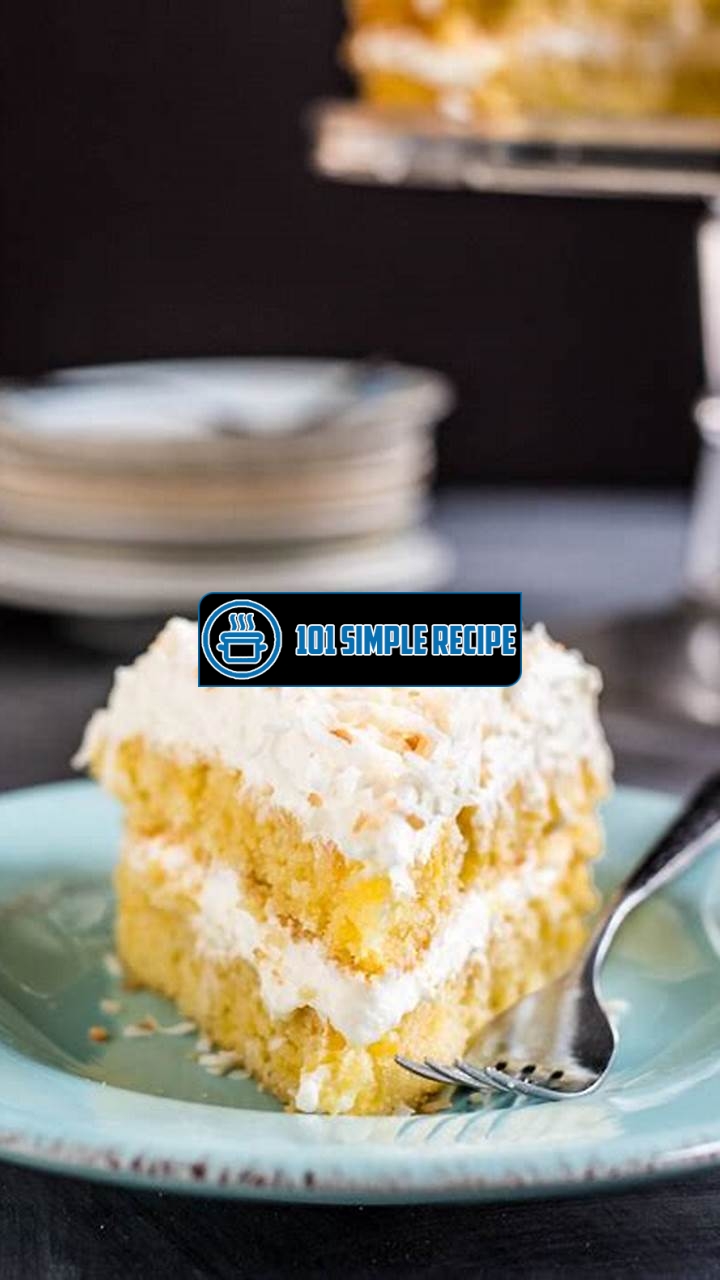Are you craving a tropical dessert that’ll transport your taste buds to paradise? Look no further than this delectable Pineapple Coconut Cake recipe! Bursting with the refreshing flavors of pineapple and coconut, this moist and fluffy cake is the perfect treat for any occasion. Whether you’re hosting a summer BBQ, celebrating a special event, or simply satisfying your sweet tooth, this recipe is sure to impress.

History of Pineapple Coconut Cake
Pineapple coconut cake is a delectable dessert that has a rich history and cultural significance in various parts of the world. This irresistible cake combines the tropical flavors of pineapple and coconut, creating a delightful treat that is enjoyed by many. Let’s explore the origins of this cake and how it has become a beloved dessert in different cultures.
The Tropical Connection
The combination of pineapple and coconut in cake recipes is often associated with tropical regions such as the Caribbean and Southeast Asia. These areas are known for their abundant supply of fresh pineapples and coconuts, making them the perfect ingredients for creating delicious desserts.
In the Caribbean, pineapple coconut cake is a popular dessert that is often served during celebrations and festive occasions. The tropical flavors of the cake are a reflection of the vibrant culture and natural beauty of the region. The sweetness of the pineapple complements the richness of the coconut, resulting in a truly indulgent treat.
Similarly, in Southeast Asia, pineapple coconut cake holds a special place in the hearts of locals. It is commonly served during festivals and religious ceremonies as a symbol of good luck and prosperity. The combination of these two tropical ingredients not only adds flavor to the cake but also enhances its cultural significance.
Regional Variations
Although pineapple coconut cake is enjoyed worldwide, different regions have their own unique twists on the recipe. In some areas, the cake is baked using fresh pineapple chunks and shredded coconut, while in others, it is made with canned pineapple rings and desiccated coconut.
In Hawaii, for example, pineapple coconut cake is often referred to as “Haupia Pineapple Cake.” Haupia is a traditional Hawaiian coconut pudding, which is layered with pineapple slices and coconut-flavored cake. This variation adds an extra layer of creaminess and tropical flavors to the cake.
In the Philippines, a popular variation of the pineapple coconut cake is called “Buko-Pandan Cake.” This version incorporates pandan, a fragrant leaf commonly used in Southeast Asian desserts, which enhances the aroma and flavor of the cake.
Additionally, some recipes include rum or rum extract, giving the cake a boozy twist and an added dimension of flavor.
Traditional Occasions for Pineapple Coconut Cake
Throughout history, pineapple coconut cake has been associated with various traditional occasions and celebrations. In many Caribbean countries, it is a staple dessert during Christmas and Easter festivities. These cakes often have festive decorations, such as coconut flakes resembling snow or colorful icing depicting holiday symbols.
In Hawaii, pineapple coconut cake is commonly served at luaus and other social gatherings. This tropical dessert adds a touch of authenticity to the traditional Hawaiian feast and leaves a lasting impression on visitors.
Overall, pineapple coconut cake is a beloved dessert that has a long and storied history. Its tropical flavors, regional variations, and cultural significance have made it a go-to dessert for a wide range of occasions. Whether you’re enjoying a slice in the Caribbean or indulging in a variation from Southeast Asia, one thing is certain – pineapple coconut cake is a treat that can transport you to the tropics with every delightful bite.
Choosing the Perfect Pineapple
When it comes to creating a delectable pineapple coconut cake, choosing the perfect pineapple is key. Not only will a ripe and flavorful pineapple enhance the taste of your cake, but it will also ensure a moist and tropical experience with every bite. In this section, you will learn how to select a pineapple that is ready to be used in your cake, guaranteeing the best possible results.
Identifying a Ripe Pineapple
To start, you must be able to identify a ripe pineapple. There are a few important factors to consider when selecting a pineapple:
- Color: A ripe pineapple typically has a vibrant golden color. Avoid choosing pineapples that have green or brown spots as they may not be fully ripe.
- Firmness: Gently squeeze the pineapple to check for firmness. It should have a slight give when pressed, but not be too soft. A pineapple that is too firm may not be ripe enough, while a pineapple that is too soft may be overripe.
- Aroma: The fragrance of a ripe pineapple is a telltale sign of its readiness. Take a whiff near the base of the fruit and look for a sweet, tropical scent. If the pineapple doesn’t have much aroma, it may not be fully ripe.
By considering these factors, you can ensure that you select a pineapple that is ripe and bursting with the sweet flavors that will complement your pineapple coconut cake.
Preparing the Pineapple for Cake
Once you’ve chosen the perfect pineapple, it’s time to prepare it for your cake. Here are the steps to follow:
- Peel the pineapple: Start by removing the outer skin of the pineapple. Cut off the crown and base, then use a sharp knife to carefully slice off the skin in downward motions, following the curve of the fruit.
- Remove the core: The tough core of the pineapple should be removed before adding it to your cake. Slice the pineapple into rings, and then use a small, round cookie cutter or a sharp knife to cut out the center core of each ring.
- Chop or crush the pineapple: Depending on your preference, you can either chop the pineapple into small pieces or use a blender to crush it into a puree. Both options will work equally well in your pineapple coconut cake.
With your pineapple now prepared, you can move on to the next steps of creating your delicious pineapple coconut cake.
Alternative Pineapple Options
In addition to using fresh pineapple, there are alternative options available that still bring the delicious tropical flavor to your cake. These alternatives include:
- Canned pineapple: If fresh pineapples are not readily available, you can opt for canned pineapple. Make sure to drain off the excess juice before using it in your cake.
- Frozen pineapple: Frozen pineapple can be a convenient option, especially if you want to have pineapples on hand all year round. Thaw it before using, and squeeze out any excess moisture.
- Pineapple juice: If you prefer a more subtle pineapple flavor, you can use pineapple juice instead. It will add a hint of tropical taste to your cake without the need for chopping or crushing.
By exploring these alternative pineapple options, you can still enjoy the tangy and sweet flavors in your pineapple coconut cake, regardless of the availability of fresh pineapples.
Coconut: A Key Ingredient
Discover the different forms of coconut and how they enhance the flavor and texture of pineapple coconut cake.
Using Fresh Coconut
One of the best ways to elevate the taste of your pineapple coconut cake is by using fresh coconut. The natural sweetness and tropical aroma of fresh coconut can take your cake to a whole new level of deliciousness.
To incorporate fresh coconut into your cake, you’ll need to crack open the coconut and extract the meat. Start by piercing the softest “eye” of the coconut with a sharp object and drain out the coconut water, which you can save for other recipes or enjoy as a refreshing drink. Once drained, firmly hit the coconut against a hard surface to crack it open. Use a butter knife to carefully pry the meat away from the shell.
Next, grate the coconut meat using a box grater or a food processor fitted with a grating attachment. The grated coconut will add a delightful texture and bursts of flavor to your cake. Make sure to use the fine side of the grater to achieve a more uniform texture.
Working with Coconut Milk
Coconut milk is another essential ingredient that can enhance the taste and moistness of your pineapple coconut cake.
To make coconut milk, you’ll need to extract the liquid from the grated coconut meat. Place the grated coconut in a clean piece of cheesecloth or a fine-mesh strainer, and squeeze out the milk into a bowl. The resulting liquid is coconut milk, and it can be used as a substitute for regular milk in the cake batter.
Coconut milk adds a creamy richness and subtle coconut flavor to your cake. It also helps keep the cake moist and tender. When using coconut milk in your recipe, be sure to mix it well with the other wet ingredients before incorporating them into the dry ingredients. This ensures an even distribution of flavors throughout the cake.
Exploring Coconut Flakes
Coconut flakes are a versatile ingredient that can add an extra layer of texture and visual appeal to your pineapple coconut cake.
You can find coconut flakes in most grocery stores, and they come in different sizes and textures, from fine flakes to larger pieces. For your cake, opt for larger flakes, as they will add a beautiful flaky texture that contrasts well with the softness of the cake.
To incorporate coconut flakes into your cake, simply sprinkle them on top of the batter before baking. As the cake bakes, the flakes will toast slightly, adding a lovely golden hue and a deliciously nutty flavor to each bite. You can also add a handful of coconut flakes to the cake batter itself for an extra burst of coconut goodness.
Remember, when working with coconut flakes, it’s essential to toast them lightly before using them in your cake. This enhances their flavor and gives them a satisfying crunch. To toast the flakes, spread them evenly on a baking sheet and bake them at a low temperature (around 300°F/150°C) for a few minutes, keeping a close eye on them to prevent burning.
By utilizing fresh coconut, coconut milk, and coconut flakes, you can create a pineapple coconut cake that is bursting with tropical flavors and irresistible textures. Don’t be afraid to get creative and experiment with different coconut variations to make your cake truly your own. Happy baking!
To make this pineapple coconut cake recipe extra special, try adding a peach lemonade recipe as a refreshing beverage to serve alongside.
Top Tips for a Moist and Fluffy Cake
Master the techniques and tricks to ensure your pineapple coconut cake is moist, fluffy, and irresistibly delicious.
Proper Mixing and Incorporation
One of the key factors in achieving a moist and fluffy cake is proper mixing and incorporation of ingredients. Begin by sifting your dry ingredients, such as flour and baking powder, to ensure they are well combined and free of any lumps. This step helps to create a lighter texture in your cake.
Next, when adding your wet ingredients, such as eggs, oil, and milk, be sure to mix them together thoroughly. Use a whisk or an electric mixer on low speed to combine the ingredients evenly. This will help to create a smoother batter and prevent any clumps or pockets of dry ingredients in your cake.
Additionally, when incorporating the pineapple and coconut into the batter, make sure they are evenly distributed. Use a spatula to gently fold them into the mixture, ensuring that every bite of cake will be bursting with tropical flavors.
Remember, proper mixing and incorporation are crucial for a well-balanced and moist cake.
Baking and Cooling Techniques
The baking and cooling process can greatly affect the moisture and texture of your pineapple coconut cake. To achieve the perfect cake, consider the following techniques:
- Baking time and temperature: Follow the recipe instructions for the recommended baking time and temperature. This will ensure that your cake is cooked through evenly and does not become dry or overcooked.
- Don’t overmix: Be mindful not to overmix the batter, as this can result in a dense and tough cake. Mix until the ingredients are just combined to avoid overworking the gluten in the flour.
- Cooling upside down: Once the cake is baked, remove it from the oven and invert it onto a cooling rack. This technique helps to prevent the cake from collapsing and losing its fluffiness as it cools.
- Allow sufficient cooling time: It’s important to let the cake cool completely before frosting or storing it. This allows the flavors to develop and the cake to reach its optimal texture.
By following these baking and cooling techniques, you’ll achieve a moist and fluffy pineapple coconut cake every time.
Enhancing Moisture with Syrups or Soaking
If you’re looking to take your pineapple coconut cake to the next level of moistness, consider enhancing it with syrups or soaking. This technique adds an extra layer of flavor and moisture to your cake.
One option is to brush a simple syrup or fruit juice onto the cake layers before assembling them. This will infuse the cake with additional moisture and flavor. To make a simple syrup, combine equal parts of sugar and water in a saucepan, heat until the sugar dissolves, and then allow it to cool.
Another option is to create a soaking liquid by combining coconut milk or pineapple juice with a sweetener, such as honey or sugar. Drizzle this mixture over the baked cake layers and allow it to soak in before frosting. This will further enhance the tropical flavors and keep the cake moist.
Remember to brush or soak the cake layers sparingly, as you don’t want to make the cake too wet or soggy.
In Summary
Mastering the techniques of proper mixing and incorporation, utilizing effective baking and cooling techniques, and enhancing moisture with syrups or soaking will ensure that your pineapple coconut cake is moist, fluffy, and absolutely irresistible. With these tips and tricks, you’ll create a cake that will delight your taste buds with every bite.
Whole Foods Chantilly cake recipe is another delicious dessert option that you might enjoy.
Creative Variations and Decorating Ideas
Unlock your culinary creativity with unique twists and decorative suggestions for your pineapple coconut cake. From infusing flavors with fillings and frostings to adding texture with nuts or dried fruits, there are endless possibilities to elevate the taste and presentation of this delightful dessert.
Infusing Flavors with Fillings and Frostings
Elevate the flavor profile of your pineapple coconut cake by infusing it with delicious fillings and frostings. Consider these creative ideas:
- Coconut Cream Filling: Add a layer of luscious coconut cream between the cake layers for a tropical twist. This filling enhances the coconut flavor and adds a creamy texture to each bite.
- Pineapple Compote: Create a tangy pineapple compote by simmering fresh pineapple chunks with sugar and lemon juice. Spread it between the cake layers for an extra burst of fruity flavor.
- Rum Buttercream Frosting: Boost the flavor with a rum-infused buttercream frosting. The subtle hint of rum complements the pineapple and coconut flavors perfectly.
These fillings and frostings will take your pineapple coconut cake to the next level, delighting your taste buds and impressing your guests.
Adding Texture with Nuts or Dried Fruits
Enhance the texture of your pineapple coconut cake by incorporating nuts or dried fruits. Here are some ideas to consider:
- Toasted Coconut Flakes: Sprinkle toasted coconut flakes on top of the cake for a crunchy texture and added coconut flavor. It also adds an attractive visual element.
- Crushed Macadamia Nuts: Fold in crushed macadamia nuts into the cake batter for a buttery and nutty taste. The contrasting crunch adds depth to each bite.
- Dried Pineapple Rings: Decorate the top of the cake with dried pineapple rings for a chewy and visually appealing element. It adds a touch of tropical flair.
These additions will not only enhance the taste and texture but also create an enticing visual appeal to your pineapple coconut cake.
Decorating Techniques and Presentation Tips
Make your pineapple coconut cake visually stunning with these decorating techniques and presentation tips:
- Coconut Shavings Cover: Instead of frosting the cake, cover it entirely with a layer of coconut shavings. It adds an elegant touch and highlights the coconut flavor.
- Pineapple Flower Garnish: Create a beautiful pineapple flower garnish to place on top of the cake. Simply cut a pineapple into thin slices, shape them into flower petals, and arrange them decoratively. It adds a vibrant and tropical touch.
- Edible Floral Decor: Garnish the cake with edible flowers like orchids or hibiscus. It adds a touch of elegance and a pop of color.
Remember, presentation matters as much as taste, and these decorative ideas will make your pineapple coconut cake a feast for the eyes as well.
With these creative variations and decorating ideas, you can transform a simple pineapple coconut cake into a culinary masterpiece that will impress and satisfy all who indulge in it. Enjoy exploring different flavors, textures, and presentation styles to make each cake unique and unforgettable.
For a tropical twist, you can also try making a Coca-Cola cake recipe that incorporates the flavor of your favorite soda into the cake.
Thank you for taking the time to read our delicious pineapple coconut cake recipe! We hope you enjoyed learning how to make this tropical treat. Whether you’re baking it for a special occasion or just craving a sweet and tangy dessert, this recipe is sure to satisfy. Don’t forget to bookmark our website and visit again later for more mouthwatering recipes and culinary inspiration. Happy baking!
Frequently Asked Questions
Here are some common questions about our pineapple coconut cake recipe:
| No. | Questions | Answers |
|---|---|---|
| 1. | How long does it take to bake the pineapple coconut cake? | The baking time for this cake is approximately 45 minutes to 1 hour. However, it’s important to check for doneness by inserting a toothpick into the center. If it comes out clean or with just a few crumbs, the cake is ready. |
| 2. | Can I use canned pineapple instead of fresh? | Yes, you can use canned pineapple in this recipe. Just make sure to drain the pineapple well before incorporating it into the batter. |
| 3. | Can I omit the coconut flakes? | If you’re not a fan of coconut or don’t have any on hand, you can omit the coconut flakes. However, keep in mind that it might alter the texture and flavor of the cake slightly. |
| 4. | Can I use a different type of frosting? | Absolutely! While we recommend using cream cheese frosting for its creamy and tangy taste, you can use any frosting of your choice. Vanilla or coconut frosting would also pair well with this cake. |
| 5. | How should I store the leftover cake? | To keep the cake fresh, store it in an airtight container in the refrigerator. It should last for up to 3-4 days. |
| 6. | Can I freeze this cake? | Yes, you can freeze the pineapple coconut cake. Wrap it tightly in plastic wrap or place it in an airtight container before freezing. Thaw it in the refrigerator overnight before serving. |
Closing Thoughts
We hope this pineapple coconut cake recipe brings a taste of the tropics to your kitchen. From the juicy pineapple chunks to the sweet coconut flakes, every bite is bursting with flavor. Now that you’ve mastered this recipe, feel free to get creative and add your own twist to it. Don’t forget to share your baking adventures with us on social media. Thank you for choosing us as your culinary guide. Until next time, happy baking!
Jump to Recipe
Pineapple Coconut Cake Recipe

Learn how to make a tropical pineapple coconut cake from scratch. This moist and flavorful cake is perfect for any occasion.
- 2 cups all-purpose flour
- 1 1/2 teaspoons baking powder
- 1/2 teaspoon baking soda
- 1/4 teaspoon salt
- 1/2 cup unsalted butter (softened)
- 1 cup granulated sugar
- 2 large eggs
- 1 teaspoon vanilla extract
- 1 cup buttermilk
- 1 cup diced fresh pineapple
- 1/2 cup sweetened flaked coconut
- Preheat the oven to 350°F (175°C). Grease and flour a 9-inch round cake pan.
- In a mixing bowl, whisk together the flour, baking powder, baking soda, and salt.
- In a separate bowl, cream together the softened butter and granulated sugar until light and fluffy.
- Add the eggs, one at a time, beating well after each addition. Stir in the vanilla extract.
- Gradually add the dry ingredients to the butter mixture, alternating with the buttermilk. Begin and end with the dry ingredients, mixing just until combined.
- Gently fold in the diced pineapple and coconut flakes.
- Pour the batter into the prepared cake pan and smooth the top. Bake for 45 minutes to 1 hour, or until a toothpick inserted into the center comes out clean.
- Allow the cake to cool in the pan for 10 minutes, then transfer it to a wire rack to cool completely. Once cooled, frost the cake with your choice of frosting.
- Slice the pineapple coconut cake and serve. Enjoy!






